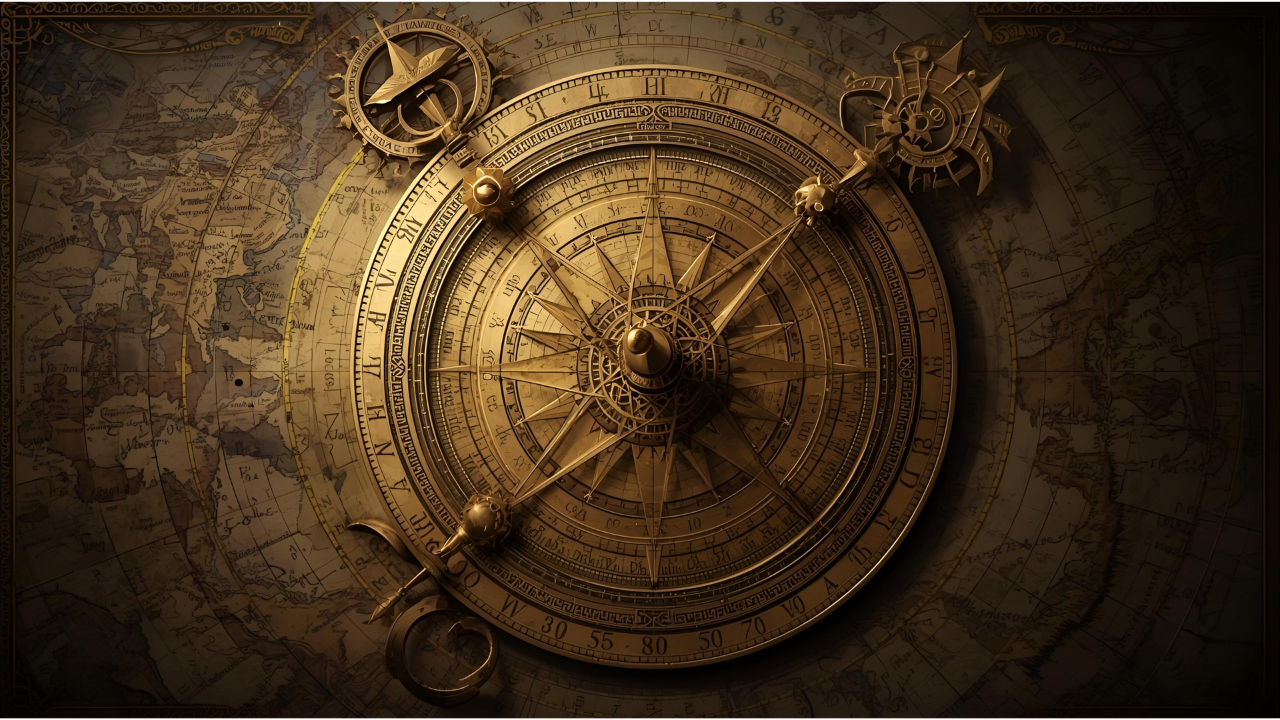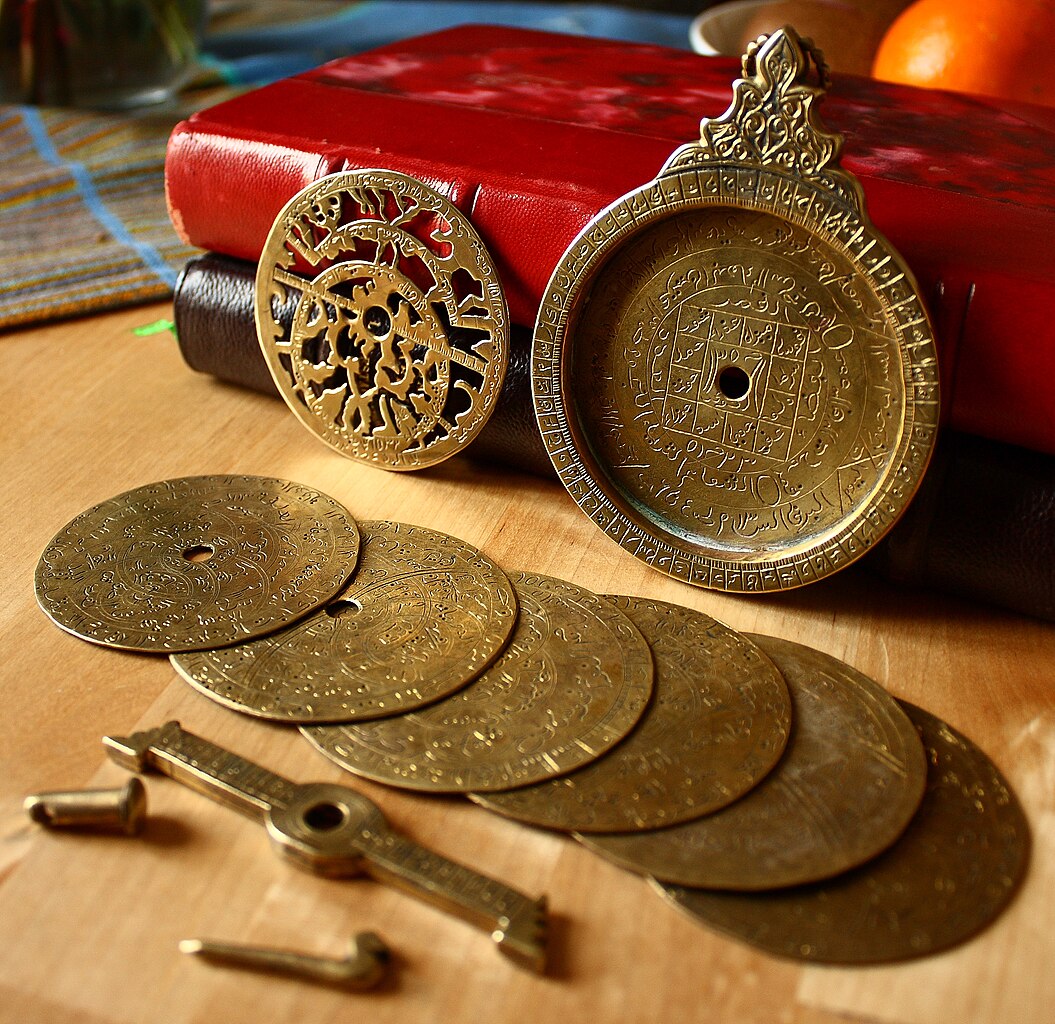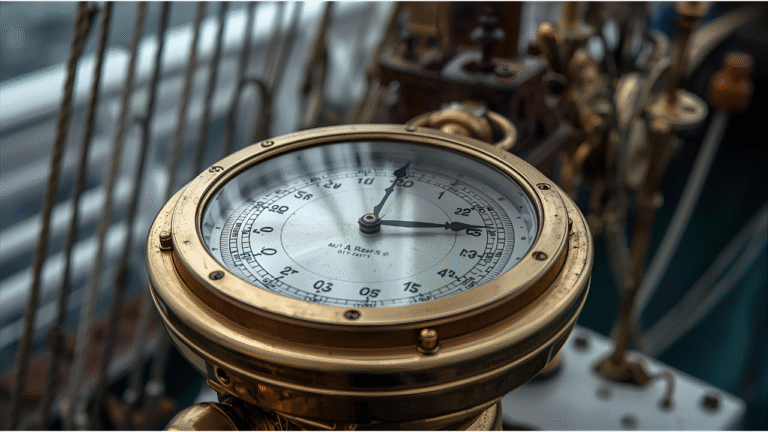Introduction
Imagine being a sailor in the 15th century, standing on the deck of a wooden ship in the middle of an endless ocean. With no GPS, no compass accurate enough for long voyages, and only the stars above to guide you—what tool would you rely on? For centuries, that tool was the astrolabe, a brilliant invention that shaped the course of navigation, astronomy, and science.
Often described as a “medieval computer,” this Celestial calculator could perform a surprising range of calculations: determining the position of the Sun and stars, estimating the time of day or night, and even helping travelers find their way across seas and deserts. It became a symbol of knowledge and exploration during the Islamic Golden Age, the European Renaissance, and beyond.

This blog will take you through the fascinating story of the Celestial calculator—starting with what is astrolabe, how this ingenious navigational instrument worked, and why it remained one of humanity’s most trusted scientific companions for over a thousand years.
What is an Astrolabe?
So, what is astrolabe exactly? In simple terms, it is an ancient analog device designed to solve astronomical and mathematical problems by modeling the sky. Think of it as a hand-held map of the heavens, small enough to carry but powerful enough to help sailors, scholars, and astronomers unlock the secrets of the universe.
At its core, the it was a multi-purpose navigational instrument that combined the functions of a clock, a calculator, and a star chart. It allowed users to:
- Measure the altitude of celestial objects like the Sun, Moon, and stars.
- Tell time, both during the day and at night, using astronomical data.
- Determine latitude, which was vital for long-distance navigation.
- Assist with religious practices, such as calculating prayer times and the direction of Mecca in the Islamic world.
Key Components
To understand what is astrolabe, it helps to look at its main parts:
- The Mater: the base or main body that held all the other pieces.
- The Rete: a rotating star map that showed the positions of important stars.
- The Plates (Tympans): flat disks engraved with coordinates, specific to different latitudes.
- The Alidade: a rotating arm on the back, used for sighting celestial objects.
Types of Astrolabes
There were two main types:
- Planispheric Astrolabe – the most common version, which projected the celestial sphere onto a flat surface. It was portable, practical, and widely used for navigation.
- Spherical Astrolabe – a more advanced, globe-shaped version that attempted to represent the sky in three dimensions, though it was rare and mostly limited to scholarly study.
By combining precision engineering with astronomical knowledge, it became much more than a simple navigational instrument. It was a universal tool of exploration—bridging science, religion, and daily life across civilizations.
Origins and Historical Evolution
The story of the astrolabe spans centuries and civilizations, making it one of the richest chapters in itshistory. This ingenious navigational instrument was not the creation of a single culture, but rather a product of shared human curiosity about the skies.
Greek Beginnings
The foundations of this Celestial calculator go back to ancient Greece. Around 150 BCE, the astronomer Hipparchus developed the principle of stereographic projection—a method of projecting the three-dimensional sky onto a two-dimensional plane. This concept was later expanded by Ptolemy in his influential work Planisphaerium, which described how the heavens could be represented on a flat surface. Though early prototypes were crude, they set the stage for what would become one of the most advanced scientific instruments of the medieval world.
Islamic Golden Age
Between the 8th and 13th centuries, scholars of the Islamic world transformed and perfected the Celestial calculator. Renowned figures like Al-Farghani, Al-Sufi, and Al-Biruni refined its design, expanded its mathematical applications, and wrote detailed treatises on its use. The Islamic astrolabe became indispensable not only as a navigational instrument but also in daily religious life—helping to determine the times for prayer and the direction of Mecca (qibla).
Medieval Europe
By the 10th century, knowledge of the Celestial calculator had spread into Europe through Spain, Sicily, and other centers of cultural exchange. Monasteries and universities began teaching its use, and it became a key part of the curriculum for scholars studying astronomy, geometry, and timekeeping. Navigators and explorers, particularly during the Age of Exploration, relied heavily on the Celestial calculator to chart courses across uncharted seas.
Spread Through Trade
The diffusion of the astrolabe across continents illustrates how ideas traveled along ancient trade routes. From the Mediterranean to North Africa, and from the Middle East to South Asia, this Celestial calculator bridged cultures and became a universal symbol of science and exploration. Today, museums across the world house ornate examples that testify to the global journey of this remarkable instrument.
Construction and Parts of an Astrolabe
Understanding Celestial calculator construction is essential to appreciating its brilliance. Despite being created centuries ago, its design combined elegance with functionality, making it a timeless scientific tool. Each part played a specific role, and together they formed a miniature model of the cosmos.
The Mater (Base Plate)
The mater was the body of the Celestial calculator, typically made of brass or other metals, and acted as the frame that held all the components. It was engraved with scales around its edge and served as the foundation upon which the rest of the device operated.
The Tympan (Climate Plates)
Inside the mater, users inserted tympans (also called climate plates). Each tympan was engraved with coordinate lines corresponding to specific latitudes. By swapping them out, a single astrolabe could be used in different regions of the world. This feature made it especially valuable as a navigational instrument for travelers who crossed diverse territories.

The Rete (Star Map)
The rete was a skeletal, rotating disk placed on top of the tympan. Decorated with pointers for bright stars, it acted as a portable star chart. When rotated, it simulated the movement of the heavens, allowing users to align celestial positions for calculations.
The Alidade (Sighting Rule)
On the back of the Celestial calculator lay the alidade, a movable arm with sighting holes or vanes. This was used to measure the altitude of celestial objects like the Sun or stars. Once the measurement was taken, it could be applied to the front of the device to determine time, latitude, or other values.
The Quarter of an Astrolabe
An interesting variant was the quarter of an astrolabe, also called a quadrans. This was essentially a simplified version that used only one-fourth of the full circular device. Compact and easier to carry, it was especially popular among sailors and travelers who needed a more portable tool for navigation.
Visualizing the Design
When assembled, all these parts transformed the Celestial calculator into a working model of the cosmos. The mater provided stability, the tympans set the geographic context, the rete mapped the stars, and the alidade made direct observations. Together, these components turned a flat piece of metal into one of the most sophisticated instruments of the pre-modern world.
How Does an Astrolabe Work?
The true genius of the Stereographic instrument lies not just in its design, but in how elegantly it could be used to solve real-world problems. Despite its intricate appearance, this navigational instrument followed a logical, step-by-step process that sailors, scholars, and astronomers could master with practice.
Step-by-Step Use
- Aligning with a Star or the Sun
The user would hold the Medieval navigational tool vertically and rotate the alidade (the sighting rule on the back) until it pointed directly at the Sun or a visible star. This step captured the object’s altitude above the horizon. - Reading the Altitude
Once aligned, the angle was read off the degree scale engraved on the back of the Stereographic instrument. This provided the altitude measurement necessary for further calculations. - Applying the Measurement
The measured altitude was then transferred to the front, where the rete (star map) and tympan (latitude plate) could be rotated into alignment. By comparing the position of the celestial body with the engraved scales, the user could solve equations and extract useful information.
What Could It Be Used For?
- Finding the Time – By comparing the altitude of the Sun or stars with their expected positions, users could calculate the time of day or night.
- Determining Latitude – Sailors measured the altitude of the Sun at noon or Polaris at night to establish their latitude at sea.
- Astronomical Observations – Scholars used the astrolabe to predict the rising and setting of stars, planetary positions, and even eclipses.
Practical Examples
- For a Sailor: Crossing the Indian Ocean, a navigator might use the astrolabe at night to measure the height of Polaris, confirming his latitude and ensuring the ship stayed on course.
- For an Astronomer: A scholar in Baghdad could measure the altitude of Venus, then rotate the rete to calculate when the planet would next rise.
- For a Student or Monk: In medieval Europe, this Medieval navigational tool could help track the equinoxes, vital for calculating the date of Easter.
Even a quarter of an astrolabe could perform many of these tasks in simplified form, proving that this tool—whether full or partial—was among the most versatile navigational instruments ever created.
Variants and Related Instruments
Over time, the astrolabe evolved into several different forms, each adapted for specific needs. These variations highlight its flexibility as a scientific and navigational instrument.
The Quarter of an Astrolabe
One of the most practical adaptations was the quarter of an astrolabe, also known as the quadrans. This device represented one-fourth of a full Stereographic instrument, making it lighter, more portable, and easier to use at sea. Sailors valued it because it could measure altitudes and determine latitude without requiring the bulk and complexity of the full instrument. While it lacked some of the advanced astronomical features, its simplicity made it ideal for long voyages.
The Universal Astrolabe
Unlike traditional models, which required different plates (tympans) for different latitudes, the universal astrolabe was designed to work anywhere on Earth. Developed by Islamic scholars like Al-Zarqali (known in Europe as Arzachel), this variant eliminated the need for multiple climate plates, making it highly adaptable for travelers and scientists.
Mathematical & Astronomical Astrolabes
Beyond navigation, specialized versions were developed for teaching and research.
- Mathematical astrolabes were used in universities to demonstrate geometry, trigonometry, and stereographic projection.
- Astronomical astrolabes included extra scales for predicting celestial events, planetary motion, and eclipses, expanding their role as scientific calculators.
Related Instruments
The astrolabe also inspired related tools like the mariner’s Medieval navigational tool, a simplified version optimized for sea travel, and the nocturnal, which allowed sailors to tell time at night using the stars. These devices show how the concept of the Stereographic instrument spread and influenced generations of instrument makers.
Whether it was a full-sized model, a quarter of an astrolabe, or a universal version, every adaptation demonstrated the enduring value of this navigational instrument across cultures and centuries.
Astrolabe vs Armillary Sphere
Throughout history, scholars used different instruments to model the heavens. Two of the most famous were the armillary sphere and the astrolabe. While they shared the same goal—understanding the sky—they differed in design, purpose, and application.
The Armillary Sphere
An armillary sphere was a three-dimensional skeletal model of the celestial sphere. Built from a series of metal rings (armillae) representing the equator, tropics, and celestial meridians, it showed how the stars and planets moved around Earth. It was mainly used as a teaching tool in universities and academies to explain astronomy visually.
The Astrolabe
The Medieval navigational tool, by contrast, was a two-dimensional projection of the sky. Using stereographic projection, it flattened the celestial sphere onto a disk, creating a portable, functional device. Unlike the sphere, the Stereographic instrument wasn’t just for demonstration—it was a practical navigational instrument used daily by sailors, scholars, and travelers.
Applications Compared
- Armillary Sphere → Ideal for education, theory, and demonstrating astronomical principles.
- Astrolabe → Best for field use, solving real-world problems like finding the time, locating stars, and navigating at sea.
Comparative Chart: Armillary Sphere vs Astrolabe
| Feature | Armillary Sphere | Astrolabe |
|---|---|---|
| Structure | 3D skeletal model of celestial sphere | 2D projection of the sky onto a flat disk |
| Main Use | Teaching and demonstration | Practical field tool for navigation & time |
| Portability | Large, heavy, not portable | Compact, portable, easy to carry |
| Audience | Scholars, educators | Sailors, astronomers, travelers |
This contrast shows why the armillary sphere astrolabe debate often centers around theory versus practice—one demonstrated cosmic order, while the other put the stars to work.
Scientific & Cultural Impact
The astrolabe importance cannot be overstated. For nearly 1,000 years, this brilliant navigational instrument shaped science, religion, and culture across civilizations.
Role in Islamic Civilization
During the Islamic Golden Age, the astrolabe became indispensable in daily religious life. It was used to calculate prayer times with precision, determine the qibla (direction of Mecca), and track the Islamic lunar calendar. Scholars like Al-Biruni wrote detailed treatises on its use, cementing its role as both a scientific and spiritual tool.
Navigation in the Age of Exploration
In the 15th and 16th centuries, European sailors relied on the astrolabe to cross vast oceans. By measuring the altitude of the Sun or Polaris, explorers could calculate latitude and chart their journeys into uncharted waters. Without this navigational instrument, landmark voyages—such as those of Vasco da Gama and Christopher Columbus—would have been nearly impossible.
Contribution to Astronomy & Mathematics
The Medieval navigational tool advanced knowledge in trigonometry, geometry, and astronomy. It allowed scholars to visualize complex celestial movements and paved the way for later discoveries about planetary orbits and timekeeping.
Influence on Clocks and Early Computers
Historians often describe the Stereographic instrument as a precursor to mechanical clocks and even computers. Its ability to solve multiple problems through gears, plates, and projection directly inspired the engineering principles behind later devices. In many ways, the astrolabe was humanity’s first step toward the age of mechanized calculation.
Decline and Legacy
Like many great inventions, the astrolabe eventually gave way to newer technologies. By the 17th century, it was replaced by more accurate and specialized tools such as the sextant, the magnetic compass, and precision mechanical clocks. These instruments offered greater reliability at sea and reduced the need for the complex calculations required by the Medieval navigational tool.
Yet the legacy of the astrolabe endures. Even though it is no longer a frontline navigational instrument, it remains invaluable as a teaching tool in astronomy and history. Museums, universities, and planetariums around the world showcase beautifully crafted replicas that highlight both the scientific and artistic achievements of past civilizations.
Today, the astrolabe stands as a symbol of the fusion between science and art—its intricate engravings and elegant design reflecting a time when knowledge was both practical and beautiful. For historians, scientists, and enthusiasts alike, the Stereographic instrument continues to represent one of humanity’s most extraordinary attempts to understand the universe.
Conclusion
This Celestial calculator was far more than just a tool; it was the “smartphone of the medieval world”—a compact, multifunctional device that helped sailors, scholars, and astronomers unlock the secrets of the heavens. To answer the question “what is astrolabe”, it is best understood as a navigational instrument and analog computer that bridged science, religion, and exploration for centuries.
While the armillary sphere vs astrolabe debate highlights different strengths—one being a 3D teaching model and the other a portable problem-solving device—the Medieval navigational tool stands out for its practicality and versatility. Its enduring legacy lies not only in navigation but also in shaping mathematical thought, timekeeping, and even the way civilizations structured daily life around the cosmos.
By studying this remarkable invention, we recognize the astrolabe’s role in shaping the course of human history, reminding us that today’s digital technologies are deeply rooted in the ingenuity of the past.
📌 Enjoyed learning about the astrolabe?
You might also like these fascinating reads:






